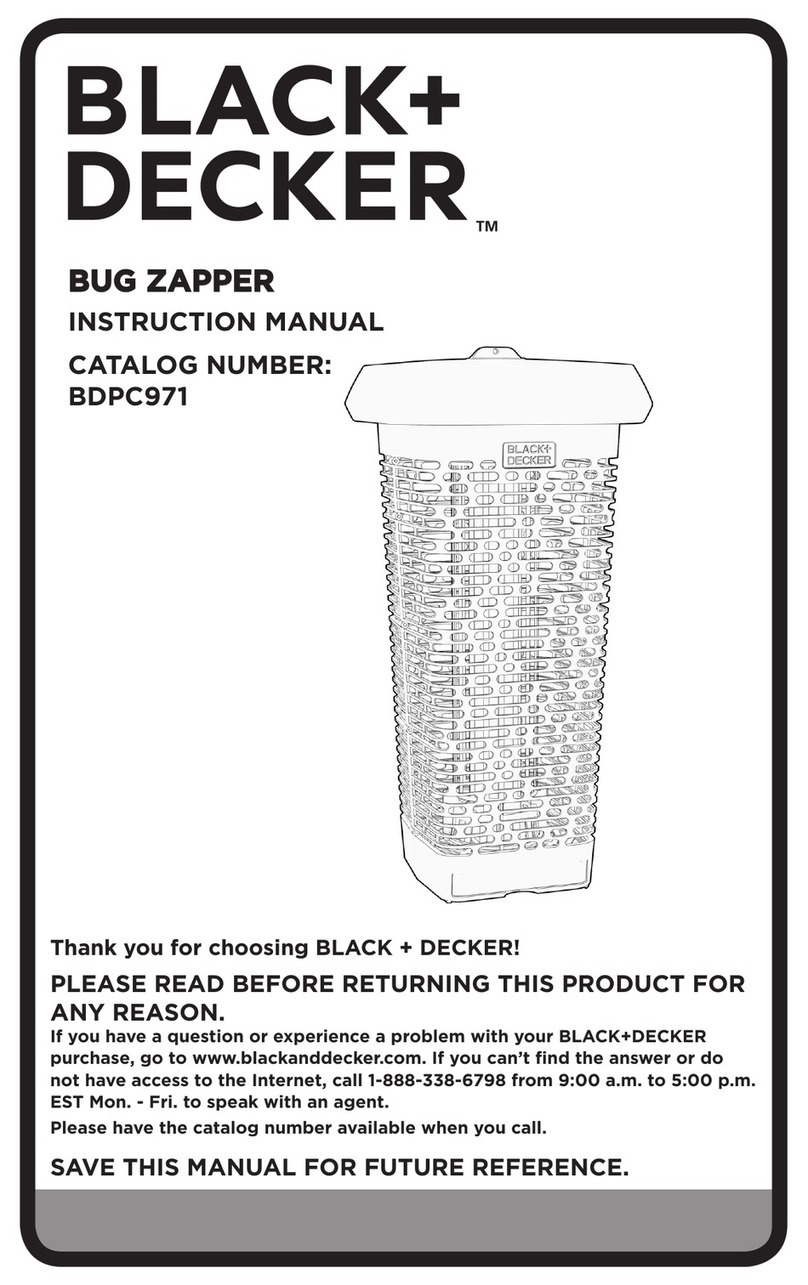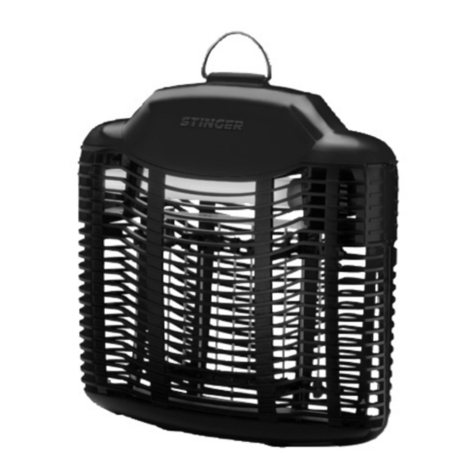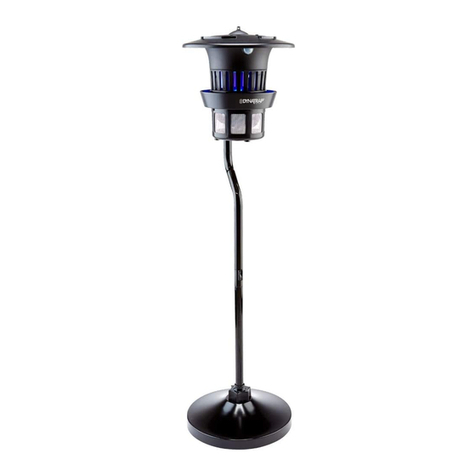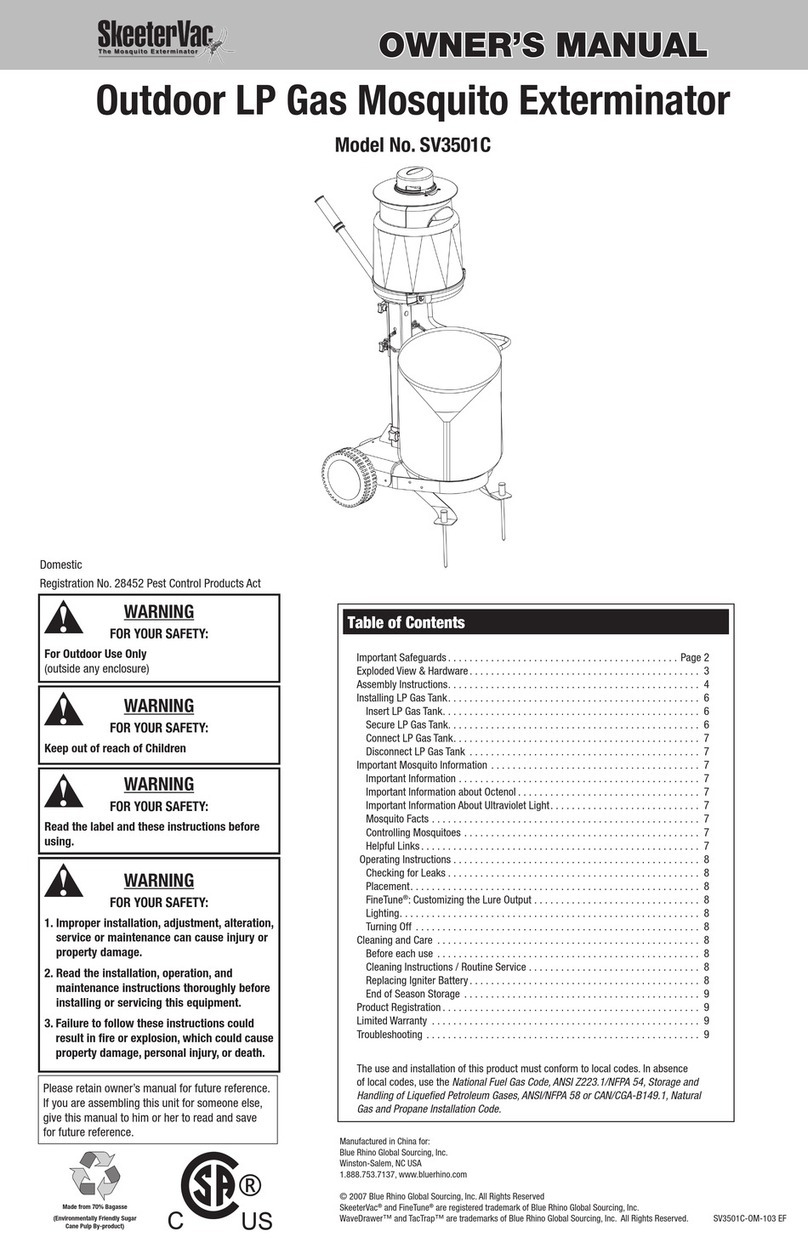The Fountainhead Group Burgess Portable Propane Insect Fogger User manual

InsectFogger
Use and Care Manual
Burgess
Do Not Return This Fogger To The Store
For Help, Information or Parts, Call : 1-800-311-9903
The Fountainhead Group, Inc.
23 Garden St., New York Mills, NY 13417
1-800-311-9903
www.TheFountainheadGroup.com
CAUTION: Read and follow all instructions
PortablePropane
®
Manual No. 161856
Rev C. 01/08/2013
ECN13-006
5 1/2”x 8 1/2” Booklet

Page 1
Principle of Fogging
(Before Using, be sure to read and follow all instructions, including the
instructions on the chemical to be used.)
Fogging is one of the most eective and economical means of applying insecticide. The
Burgess® Fogger adds the convenience of total portability for today's mobile,
outdoor-oriented living.
The secret of fogging's success lies in its ability to reduce insecticide into microscopic particles
averaging 15 microns in diameter (a micron measures 1/25,000 of an inch). By contrast, mist
droplets range from 50 to 125 microns; spray droplets more than 125 microns.
The tiny particle size allows the fog to spread through the air, penetrating shrubbery and
other insect havens. The result is that more insecticide particles come in contact with more
insects for greater kill. Yet fogging uses far less insecticide than conventional sprays.
The basic components of the fogger are a mechanical pump, a burner assembly fueled by
propane gas, a heat-conducting coil, and an insecticide jar (See Fig. 1)
By squeezing the trigger slowly and steadily, every 3 to 4 seconds, the pump forces
insecticide through the heat-conducting coil. The heat vaporizes the insecticide instantly, and
a stream of fog surges out of the nozzle.
LIMITED WARRANTY
We warrant that each product sold by us will be free from defects in material and workmanship
for a period of one year from the date of shipment by us. We make no other express warranties,
and all implied warranties, including tness and merchantability, are limited to one year from
date of shipment by us. Within the warranty period, we will repair or replace any part found to
be defective upon our examination but will not pay shipping cost or other expenses.
BEFORE YOU BEGIN

To obtain warranty service, call us at The Fountainhead Group, Inc. - Customer Service Center-
Access online at: www.TheFountainheadGroup.com. Merchandise may not be returned without
prior permission and must be returned to us with freight prepaid. This warranty service is an
exclusive remedy and we are not responsible for any consequential or incidental damages or
injury to person or property. This warranty shall not apply to any product which has been
subject to misuse, negligence or accident, or been damaged in shipment, or misapplied, or
which has been modied or repaired by unauthorized persons. This warranty only applies to
products owned by persons purchasing directly from us or from our approved distributors and
merchandisers. The right is reserved to incorporate subsequent design or parts changes after
publication and without re-issue of descriptive literature or catalogs.
NOTE: Limitations on duration of implied warranty and/or consequential damages may not
apply to you if your state does not permit them. This warranty gives you specic legal rights in
addition to rights which you may have under state law.
Page 2
Where and when to fog
The Burgess® Fogger is designed to provide fast control of mosquitoes, ies
and other ying pests in outdoor areas such as yards, patios, picnic areas,
campgrounds, and other places where insects can spoil outdoor living.
The ideal time to fog is around dusk, when the wind has usually died down and
the temperature at ground level is somewhat higher than that of the air a few
feet o the ground. This temperature inversion will tend to hold the fog in the
treated area for a longer period of time. It is not advisable to attempt fogging
when the wind is blowing harder than ve miles an hour, since the fog will be
blown away before it has the opportunity to be eective.
Never use wet fog on plants, shrubs or outdoor carpeting, etc., since the oily
residue could have damaging eects. Keep the fogger about 5 feet away from
the objects being treated, and let the fog drift in the desired direction. At this
distance, any non-vaporized particles of insecticide will have settled to the
ground. Always keep the breeze at your back when operating the fogger.
DO NOT use the Burgess® Propane Fogger indoors or in an enclosed area. The
unit uses an open ame, and operating the Fogger in an enclosed area, where
fog can become heavily concentrated, may cause re or explosion.
Outdoor
Use Outdoors
Only
Indoor
Do Not Use
Indoors
BEFORE YOU BEGIN CONTINUED

Page 3
Dry and wet fog
Dryness or wetness of the fog is controlled by the rate of pumping. Pumping at the
recommended rate of once every 3 to 4 seconds will produce the most eective fog. The
dryness of the fog can be determined by passing a piece of dry cardboard through the fog
about 18 inches from the end of the nozzle. If the cardboard appears wet you are pumping
too fast. Fog should appear white in color. If fog appears brown or yellow in color you are
pumping too slow.
Dry fog is recommended. This increases the penetrating ability of the insecticide and allows
the fog to cover a larger area. Wet fog contains particles of insecticide that may not have been
completely vaporized. The oily residue left by wet fog may be harmful to certain species
of owers, growing plants, outdoor carpeting, etc.
Use Only Black Flag® Fogging Insecticide Formula 2
1. The fogger is a dispenser of insecticides. Results obtained are directly related to the
insecticide used. In order to produce a fog, the insecticide must have the proper oil base.
Black Flag® Fogging Insecticide Formula 2 has the proper oil base. Do not use emulsiable
concentrate or other materials designed to be mixed with water.
2. USE ONLY BLACK FLAG® FOGGING INSECTICIDE FORMULA 2. Your Burgess® Insect Fogger is
designed to be used with Black Flag® Fogging Insecticide Formula 2. The use of other
insecticides or chemicals may damage your fogger and could result in unsafe conditions.
3. The use of other insecticides such as Dibrom or Vapona will clog the vapor coil of your fogger,
make it inoperable and void the warranty.
Safety Precautions
1. Important: Read entire owners manual before operating the fogger. ALWAYS WEAR
PROTECTIVE CLOTHING (GLOVES, GOGGLES).
2. Use only Black Flag® Fogging Insecticide Formula 2. Your Burgess® Insect Fogger is designed
to be used with this insecticide only. The use of other insecticides or chemicals may damage
your fogger and could result in unsafe conditions thereby voiding the warranty. Always follow
the insecticide label instructions.
3. Keep your face, hands, and clothing away from the mesh burner cover at all times. The mesh
burner cover becomes very hot while in operation.
4. Do not breathe insecticide fog or vapors.
5. Operate the fogger outdoors only. DO NOT USE INDOORS or within any enclosed structure.
Always keep the fogger away from ammable materials. Do not smoke while lling and/or
operating the unit. Remove or cover exposed food and drinking water before application.
Contamination, re, or explosion could occur.
BEFORE YOU BEGIN CONTINUED

6. Never leave the fogger unattended while the burner is lit.
7. Always pre-heat your fogger for at least 2 minutes while keeping the fogger level to the
ground. Failure to pre-heat may clog the burner orice causing damage to the unit.
8. Do not allow adults, children, or pets to enter until vapors, mists, and aerosols have
dispersed. Do not apply this product in a way that will contact adults, children or pets either
directly or indirectly through drift. Do not remain in treated area. Exit area immediately and
remain outside the treated area until aerosols, vapors and/or mists have dispersed. Keep
fogger, propane cylinder, and insecticide out of the reach of children.
9. Always operate your fogger in an upright position. Never turn the unit upside down.
10. Do not over tighten the fuel valve. Your fogger will continue to burn for a short while
(up to 1 minute) after the valve is turned o. Over tightening may cause damage to your
fogger.
11. Always inspect the threaded outlet of the propane fuel cylinder and remove any dirt that
may be there. Improper attachment of the propane gas cylinder to the fogger may result in
a gas leak. Care must be taken not to cross thread when attaching the cylinder into the valve.
12. Never store propane cylinders in living spaces or attached to the fogger. Always store them
in a cool, well ventilated space. Propane cylinders are under high pressure. Do not handle
them roughly.
13. Do not incinerate the propane cylinder or insecticide container when empty. PROPANE
FOGGER DISPOSAL: Burgess® Insect Fogger is reusable. However, if it is desired or necessary
to discard, detach propane cylinder and dispose of according to disposal instructions
present on cylinder. Then place propane fogger in trash or oer for recycling or
reconditioning if available.
14. Do not overll insecticide jar. Turn o propane valve and allow unit to cool before relling.
15. Propane gas cylinders are under high pressure. Do not handle cylinders roughly. Follow
instructions on cylinder label.
16. Always follow insecticide label instructions. Insecticide containers should be disposed
of properly when empty.
17. Always store fogger indoors. Always wait for the fogger to cool before storing.
18. Trigger lock should always be in lock position (push lock button to the right) when not in use.
This will prevent accidental pumping of insecticide into the coil. An accumulation of
insecticide in the coil may cause liquid discharge when starting up the unit. Such a
concentrated discharge may ignite or stain clothing, outdoor carpeting, etc. and may be
harmful to grass or foliage.
Page 4
BEFORE YOU BEGIN CONTINUED

1. Make sure that the trigger is locked by pushing locking button in front of trigger to
the right (See Fig 2). This will prevent the accidental pumping of insecticide into the
coil.
2. Unscrew the plastic insecticide jar and ll with Black Flag® Fogging Insecticide
Formula 2. Do not overll. The insecticide should be free of lint or other foreign matter that
may clog the pump mechanism. Straining the liquid through a lint-free cloth before pouring it
into the container will insure its cleanliness. Make sure the container is screwed on securely so
that it will not come loose while the unit is in operation. USE ONLY WITH BLACK FLAG®
FOGGING INSECTICIDE FORMULA 2. Your Burgess® Insect Fogger is designed to be used with
Black Flag® Fogging Insecticide Formula 2. The use of other insecticides or chemicals may
damage your fogger and could result in unsafe conditions.
3. The fuel valve located on the right side of the unit should be fully closed (turn completely
clockwise). Insert the propane container into the channel in back of the fogger. Push slightly
to engage threads, turning clockwise until cylinder is rmly threaded in place.
4. Always inspect the threaded outlet of the propane fuel cylinder and remove any dirt or debris
that may be present.
To lock trigger
Fig 2
Page 5
PREPARING FOGGER FOR OPERATION

Page 6
1. Make sure that the trigger is locked.
2. Place fogger on a level surface when lighting and preheating.
3. Strike match and place under coil visible through shroud. (Fig. 3)
4. Open fuel valve a maximum of 1/4 turn. Ignition will take place immediately.
5. Should the gas blow the match out, turn gas o and wait 30 seconds before attempting to
re-ignite.
6. If burner will not light, make sure propane gas cylinder is not empty, is screwed in securely,
and not cross threaded (no tank threads should be visible). Do not permit gas to escape
without prompt ignition.
7. Allow the fogger to pre-heat for 1-2 minutes. While pre-heating some ame may appear
around shroud. This is normal and should not be a cause for concern. Always preheat your
fogger for one to two minutes, while keeping the fogger level with the ground. Failure to
preheat the burner may cause an uncontrolled ame in the fogger burner, should the
fogger be pointed toward the ground. Failure to preheat the burner may also clog the
burner orice, damaging your fogger.
8. Release the trigger lock and the fogger is ready to operate.
OPERATING INSTRUCTIONS

Page 7
Turning o the Fogger
When you have nished fogging:
1. Push the trigger lock to the right to lock the trigger.
2. Allow the Insecticide already in the coil to completely fog out. This will take 1 to 2 minutes.
3. When the fog being emitted becomes sporadic, shut o the propane gas by turning the fuel
valve clockwise. DO NOT OVER TIGHTEN THE FUEL VALVE. Your fogger will continue to burn for
a short while (1 - 2 minutes) after the valve is turned o. Over tightening will cause serious
damage to your fogger.
4. Let the fogger cool o before storing.
Operating Fogger Procedures
1. For a proper dry fog, pump trigger at 3 to 4 second intervals. Too frequent pumping will result
in a wet fog.
2. If a ame appears at the end of the nozzle, stop pumping immediately. Turn propane valve o.
Place fogger on a stable, non-ammable surface. Flame will stop after excess insecticide is
eliminated.
3. CAUTION: The shroud will become very hot while in operation. Do not let it come into contact
with skin, clothing or any combustible material. Always operate your fogger with the barrel
level with the ground. Pointing your fogger down may allow liquid propane to plug the torch,
cause a are up, or uncontrolled burn.
NOTE: Black Flag® Fogging Insecticide Formula 2 is temperature sensitive and may lose
eectiveness if overheated. Properly heated Black Flag® Fogging Insecticide Formula 2 will
produce a white tinted fog. Overheated Black Flag® Fogging Insecticide Formula 2 will produce
a fog with a brown or yellow tint. If the insecticide overheats, increase the rate of pumping until
the insecticide cools o. Over pumping will produce liquid at the nozzle.
Fuel Cylinders for the Fogger
1. The fogger is fueled by any standard propane gas cylinder. Each cylinder will provide
approximately 2½ hours of continuous fogging.
2. You can purchase additional propane cylinders at most hardware, discount and sporting
goods stores.
3. We recommend the use of the 14.1 oz., tall style propane cylinder (3" diameter X 10.5"
long). The use of the shorter, 16 oz. lantern cylinders may cause a are up or uncontrolled
burn.
4. Most fuel cylinders come with a protective cap over the gas outlet. Replace this cap when
you store the fuel cylinder. Before storage or use, make sure the fuel outlet is clean and free
of debris.
OPERATING INSTRUCTIONS CONTINUED

Storage
1. Remove the propane cylinder from the fogger and store in a cool, well ventilated area, out
of reach of children.
2. Do not store insecticide in fogger container.
3. When storing the units for a long period of time, ush out the insecticide container and the
fogger by pumping kerosene through the system. DO NOT LIGHT UNIT. This will safeguard
against insecticide corrosion or clogging, and will insure top performance.
4. Store fogger, insecticide, and propane gas cylinder away from children.
Page 8
Care and Maintenance
1. Insecticides provide lubrication for the fogger's pump so no additional lubrication is
necessary.
2. If the nozzle or coil should become clogged, remove and clean nozzle with a small
diameter wire. With nozzle end pointed toward oor, insert wire in coil to check for and
remove carbon build up.
3. The burner assembly in your fogger is not customer serviceable. If the burner assembly fails to
light or will not stay lit, return your fogger for factory service.
MAINTENANCE

Page 9
ATTN: Allow fogger to cool before servicing.
3. Pump Parts Kit 161436
3A
3B
3C
3D
3E
3F
3G
3H
3J 3K
3K
KEY# PART# DESCRIPTION
4 161811 JAR
KEY# PART# DESCRIPTION
3B 161007 JAR GASKET
3G 161013 CYLINDER ROD GASKET
KEY# PART# DESCRIPTION
1 161015 VAPOR COIL NOZZLE
KEY# PART# DESCRIPTION
3A 161006 PUMP PISTON CYLINDER
3B 161007 JAR GASKET
3C 161008 PUMP PISTON BALL
3D 161009 PUMP PISTON CYLINDER BALL
3E 161010 PUMP PISTON SPRING
3F 161011 PUMP PISTON CYLINDER SPRING
3G 161013 PUMP PISTON CYLINDER ROD GASKET
3H 161014 PUMP PISTON CYLINDER ROD SPRING
3J 181131 PUMP PISTON
3K 161065 PUMP PISTON CYLINDER ROD WASHER (2)
4
3
1. Nozzle
2
1
2. Gasket Parts Kit 161435
4. Jar
KITS AND PARTS

1. Unthread jar from fogger. 2. Unhook pump piston
cylinder.
3. Remove and discard pump
piston cylinder and
associated parts.
4. Unthread piston assembly. 6. Remove and discard
gasket from fogger.
7. Push new gasket (161007)
into place.
8. Install ball (161008) and
spring (161010) into piston
(181131). Thread piston
assembly back into place.
9. Install new rod gasket
(161013), rst rod washer
(161065), rod spring
(161014), then second
rod washer (161065).
11. Slide cylinder onto piston
and attach to pump
piston rod.
12. Thread jar back onto
fogger.
Page 10
5. Remove and discard piston
and internal parts.
10. Install cylinder ball
(161009) and cylinder
spring (161011) into
cylinder (161006).
SERVICING INSTRUCTIONS

Page 11
Trouble Look For Remedy
(Symptom) (Probable Cause) (Corrective Action)
No fog while unit heats 1.) Nozzle and/or end of coil 1.1.) Remove and clean nozzle orice
up - Burner operating obstructed or clogged. (See Figure 1 & 2).
properly.
1.2.) Remove carbon build-up from
inside the coil if necessary
(See Figure 3).
2.) Pump plugged. 2.1.) Insert a small wire or toothpick
into hole at bottom of piston
assembly to clear obstruction
(See Figure 4).
2.2.) Replace pump assembly.
3.) Piston is worn. 3.) Replace piston assembly.
4.) Improper fogging material. 4.) Use only Black Flag Fogging
Insecticide Formula 2.
No fog - Burner not 1.) Propane cylinder low or 1.) Replace propane cylinder
operating properly. empty. (See Figure 5).
2.) Propane cylinder attached 2.) Screw in the propane cylinder
improperly. securely (See Figure 5).
3.) Burner assembly fails to light 3.) Return your fogger for factory
or will not say lit. service. Do not attempt to repair
the burner assembly. Not
customer serviceable.
Dripping. 1.) Nozzle loose. 1.) Tighten nozzle securely
(See Figure 6).
2.) Excessive insecticide 2.) Pump with a lower rate.
output. (See Figure 7).
3.) Not at operating temperature. 3.) Wait 10-15 seconds before pumping.
Poor fog quality. 1.) Improper fogging material. 1.) Use only Black Flag Fogging
Insecticide Formula 2.
2.) If fog is thin or yellowish 2.) Increase your pumping rate
the pumping rate is too low. (See Figure 7).
3.) If fog is wet and dripping, 3.) Decrease your pumping rate
the pump rate is too high or (See Figure 7).
it has not reached operating
temperature.
Flare up or uncontrolled 1.) Fogger pointed toward the 1.) Always operate your fogger level
burning . ground. with ground. New propane bottles
may be more likely to are.
2.) Insecticide ignited. 2.) Stop pumping immediately. Turn
propane valve o. Flame will stop
after excess insecticide is eliminated.
TROUBLESHOOTING

Page 12
ATTN: Allow fogger to cool before servicing.
NOTE: Remove plastic barrel rst.
Figure 1
Figure 3 Figure 4
Figure 2
Enlarge view of nozzle orice.
Figure 6 Figure 7
Trigger for pump.
Figure5
Propane cylinder
TROUBLESHOOTING CONTINUED

Burgess
No devuelva este generador a la tienda
Para obtener ayuda, información o piezas,
llame : 1-800-311-9903
The Fountainhead Group, Inc.
23 Garden St., New York Mills, NY 13417
1-800-311-9903
www.TheFountainheadGroup.com
®
Manual No. 161856
Rev C. 01/08/2013
ECN13-006
5 1/2”x 8 1/2” Booklet
Generadordegaspropano
parainsectos
Manual de utilización y cuidado
ATENCIÓN: Lea y siga todas las instrucciones

Página 1
Principios de la fumigación
La fumigación es uno de los medios mas ecaces y económicos de aplicar insecticidas. EI
fumigador Burgess® agrega la conveniencia de que· esta unidad sea portálil para acomodarse
a la vida al aire libre de hoy.
El secreto del éxito del fumigador yace en su capacidad de reducir el insecticida en partlculas
microscópicas de aproximadamente 15 micrones de diámetro (un micrón equivale a 1/25.000
de una pulgada). Las gotitas de llovizna del rociador van desde 50 a 125 micrones; y las
gotitas del rociador comun son de más de 125 micrones.
La medida de las pequef’ias particulas permite que la niebla se distribuya en el aire, penet-
rando los arbustos y otros paraderos de los insectos. El resultado es que más partlculas de
insecticida entran en contacto con más insectos y por consiguiente se matan más insectos.
Asi y todo, el fumigador usa mucho menos insecticida que los rociadores convencionales.
Los componentes básicos del fumigador son una bomba mecánica, un conjunto de quemador
accionado a gas propano, un carrete de coriducción de calor y un recipiente de insecticida,
(Ver Figura 1)
Al apretar el gatillo en fonna leota y pareja, cada 3 a 4 seguridos, la bomba emite
insecticida a través del carrete conductor de calor. EI calor evapora el insecticida
instantáneamente y sale una corriente de niebla de la boqullla.
GARANTIA LIMITADA
Garantizamos que cada producto vendido por nosotros estará libre de defectos de material y
mane de obra durante un aiño desde la fecha de nuestro envlo . No damos ningún otro tipo de
garantias explcitas y todas, las garantias impiicitas, incluyendo el ajuste y la comercialización,
están limitadas a un añio desde la fecha de nuestro envlo. Dentro del periodo de garantra
repararemos o reemplazaremos cualquier parte defectuosa una vez que la hayamos examinado
pero no pagaremos los costos de envio u otros gastos, A n de obtener el servicio de garantfa,
escrlbanos a The Fountainhead Group, Inc. - Centro deservicio al cliente De lunes a viernes de 8
o Ingrese en línea a: www.TheFountainheadGroup.com
ANTES DE COMENZAR

No se debe devolver la mercaderia sin nuestra . autorizadón previa y usted debe pagar el envio.
Este servicio de garantia es una solución exclusiva y no nos hacemos responsables por
cualquier dañio consecuente o incidental o lastimaduras de la persona o dañios a la propiedad,
Esta garantia no se aplicará a ningún producto que haya sido mal usado, mal tratado o que se
haya dañiado durante el erivio; o que haya sido modicado o reparado por personas no
autorlzadas. Esta garantiá solamente se aplica a los productos que pertenecen a las personas
que los compraron directamente a nosotros o a nuestros distribuidores y comerciantes
autorlzados. Se reserva el derecho de incorporar un disei o subsecuente o cambios de partes
después de la publicadón y sin tener que volver a lmprimir la literatura descriptiva olos
cátalogos.
NOTA: las limitaciones en la duración de la garantfa implicita y/o los dañios
consecuentes no podrán ser apllcados a usted si el estado donde vive no lo permite. Esta
garantia le da derechos legales especi cos además de los derechos que usted pueda tener bajo
la ley del estado donde vive.
Dónde y cuàndo se debe fumigar
EI fumigador de Burgess eslà diseñado para proporcionar un ràpido
control de mosquitos, moscas y olros insectos voladores en el exterior,
tales como jardines, patios, àreas para picnic, campamentos y olros lugares
donde los inseclos pueden estropear un recreo al aire libre.
La hora ideal para fumigar es alrededor del atardecer, cuando por lo
general el viento calma y la temperatura a nivel del suelo es màs elevada
que la del aire unos pocos metros màs arriba del suelo. Esta inversión de
temperatura mantendrà el insecticida en el àrea tratada durante màs
tiempo. No se aconseja tratar de fumigar cuando el viento sopla màs
fuerte que 10 Km/h, ya que la niebla se volarà-antes de que pueda
serefectiva.
Nunca use lei niebla húmeda en las plantas, los arbustos o el pasto exteri-
or, etc., ya que el residuo aceitoso podria tener efectos dañinos. Mantenga
el fumigador a aproximadamente 3 metros de distancia de los objetos a
rociar, y deje que la niebla se dirija en la dirección deseada. A esta
distancia, cualquier partiula no evaporada del insecticida se caerà al suelo.
Siempre opere el fumigador con el viento soplando a sus espaldas .
No use el fumigador de propano Burgess en el interior. La unidad usa
una llama y al utilizar el fumigador en un àrea cerrada, donde la
niebla se puede concentrar, puede causar un incendio o una
explosión.
Exterior
Use Outdoors
Only
Do Not Use
Indoors
Interior
ANTES DE COMENZAR (CONTINUACIÓN)
Página 2

Niebla seca y humeda
La sequedad 0 humedad de la niebla se control a con el ritmo de bombeo. AI
bombear usando el ritmo recomendado de una vez cada 3 6 4 segundos, la niebla será más
ecaz. La sequedad de la niebla se puede determinar pasando un pedazo de cartón seco a
traves de la niebla a aproximadamente 45 cm. del extremo de la baquilla. SI el cartón se moja
quiere decir que usted está bombeando demasiado rapido. EI color de la niebla debe ser
blanco grisaceo. Si la niebla es de color azulado quiere decir que usted está bombeando muy
despado.
Se recomienda la pulverización seca. Esto incrementa la capacidad de penetración del
insecticida y permite que la pulverización cubra una área más extensa. La pulverización
húmeda contiene partículas de insecticida que pueden no estar completamente vaporizadas.
El residuo aceitoso que deja la pulverización húmeda puede dañar ciertas especies de
ores, el crecimiento de las plantas, el alfombrado exterior, etc.
Use Solamente Insecticida Nebulizador Black Flag® Formula 2
1. El nebulizador es un dispensador de insecticidas. Los resultados que pueda obtener
dependen directamente del insecticida que use. Para producir una pulverización, el
insecticida debe tener la base de aceite correcta. El insecticida nebulizador Black Flag®
Formula 2 tiene la base de aceite correcta. No use un concentrado emulsionable u otros
materiales diseñados para ser mezclados con agua.
2. USE SOLAMENTE INSECTICIDA NEBULIZADOR BLACK FLAG® FORMULA 2. Su Nebulizador de
Insectos Burgess® está diseñado para ser usado con el Insecticida Nebulizador Black Flag®
Formula 2. El uso de otros insecticida o químicos puede dañar su nebulizador y podría resultar
en condiciones no seguras.
3. El uso de otros insecticidas tales como Dibrom o Vapona atascarán el espiral de vapor de su
nebulizador, esto hará que el mismo no funcione y anulará la garantía.
Precauciones de seguridad
1. Importante: lea el manual del usuario completo antes de poner en funcionamiento el
nebulizador. SIEMPRE USE VESTIMENTA PROTECTORA (GUANTES, GAFAS DE SEGURIDAD).
2. Use solamente insecticida nebulizador Black Flag® Formula 2. Su Nebulizador para Insectos
Burgess está diseñado para ser usado con este insecticida solamente. El uso de otros
insecticidas o químicos puede dañar su nebulizador y podría resultar en condiciones no
seguras, anulando así su garantía. Siempre siga las instrucciones de la etiqueta del insecticida.
3. Mantenga su rostro, manos y vestimenta alejados de la cubierta del mechero en todo
momento. La cubierta del mechero se pone muy caliente cuando está en funcionamiento.
4. No respire vapores o pulverización del insecticida.
ANTES DE COMENZAR (CONTINUACIÓN)
Página 3

5. Opere el nebulizador en exteriores solamente. NO LO USE EN INTERIORES o dentro de una estructura
cerrada. Siempre mantenga el nebulizador alejado de material inamable. No fume mientras llena y/o
opera la unidad. Cubra o retire los alimentos expuestos y el agua potable antes de aplicarlo. Puede
ocurrir una contaminación, incendio o explosión.
6. Nunca deje el nebulizador solo cuando el mechero esté encendido.
7. Siempre precaliente el nebulizador como mínimo 2 minutos mientras mantiene el nebulizador al
nivel del suelo. Debe precalentar el mechero para evitar que se atasque el oricio del mechero y
dañe la unidad.
8. No permita que adultos, niños o mascotas ingresen hasta que el vapor, niebla y aerosoles se hayan
dispersado. No aplique este producto de manera tal que entre en contacto con adultos, niños o
mascotas de manera directa o indirecta a través del viento. No permanezca en áreas tratadas. Salga
del área de manera inmediata y permanezca afuera del área tratada hasta que los aerosoles, vapores
y/o niebla se hayan dispersado. Mantenga el nebulizador, el cilindro de propano y el insecticida fuera
del alcance de los niños.
9. Siempre opere su nebulizador en posición vertical. Nunca coloque la unidad boca abajo.
10. No presione demasiado la válvula de combustible. Su nebulizador continuará quemando durante
un corto tiempo (hasta 1 minuto) luego de que apague la válvula. Si presiona demasiado, puede
dañar su nebulizador.
11. Siempre inspeccione la salida roscada del cilindro de combustible propano y elimine cualquier
suciedad que pudiera haber allí. La colocación incorrecta del cilindro de gas propano en el
nebulizador puede causar una fuga de gas. Debe tener cuidado de no cruzar la rosca cuando
coloque el cilindro en la válvula.
12. Nunca almacene cilindros de propano en espacios habitables o junto al nebulizador. Siempre
almacene los cilindros en un espacio frío y bien ventilado. Los cilindros de propano están bajo alta
presión. No los manipule bruscamente.
13. No incinere el cilindro de propano o el contenedor de insecticida cuando estén vacíos. DESECHO
DEL NEBULIZADOR DE PROPANO: El nebulizador de insectos Burgess® es reutilizable. Sin embargo,
si desea o es necesario desecharlo, separe el cilindro de propano y deséchelo de acuerdo con las
instrucciones de desecho que se muestran en dicho cilindro. Después, deposite el nebulizador de
propano en la basura o entréguelo para su reciclaje o reparación, si esto estuviera disponible.
14. No sobrellene el contendor del insecticida. Apague la válvula de propano y permita que la unidad
se enfríe antes de volver a llenarla
15. Los cilindros de gas propano están bajo alta presión. No manipule los cilindros bruscamente. Siga
las instrucciones que aparecen en la etiqueta del cilindro.
16. Siempre siga las instrucciones de la etiqueta del insecticida. Los contenedores de los insecticidas
deben desecharse correctamente cuando están vacíos.
17. Siempre almacene el nebulizador en interiores. Siempre espere que el nebulizador se enfríe antes
de almacenarlo.
18. El seguro del disparador siempre debe estar en posición de seguro (presione el botón del seguro
hacia la derecha) cuando no esté en uso. Esto impedirá que ocurra un bombeo accidental de
insecticida en el serpentín. La acumulación de insecticida en el serpentín puede causar una
descarga de líquido cuando encienda la unidad. Tal descarga concentrada puede encender o
manchar la ropa, el alfombrado exterior, etc. y puede dañar el césped o follaje.
ANTES DE COMENZAR (CONTINUACIÓN)
Página 4

Cómo preparar el insecticida para su operación
1. Asegúrese de que el disparador esté bloqueado presionando el botón de bloqueo que se
encuentra frente al disparador al lado derecho ( Ver Fig 2 ) Esto impedirá el bombeo
accidental de insecticida en el serpentín.
Para bloquear
el disparador
Fig 2
2. Desatornille el contenedor plástico del insecticida y llénelo con Nebulizador para Insectos
Black Flag® Formula 2. No sobrecargue. El insecticida debe estar libre de pelusas u otra materia
extraña que pueda atascar el mecanismo de bombeo. Filtre el líquido a través de un paño sin
pelusas antes de verterlo en el contenedor para asegurarse de que esté limpio. Asegúrese de
que el contenedor esté atornillado de manera segura para que no se desprenda mientras la
unidad está en funcionamiento. USE SOLAMENTE CON INSECTICIDA NEBULIZADOR BLACK
FLAG® FORMULA 2. Su Nebulizador para Insectos Burgess® está diseñado para ser usado con el
Insecticida nebulizador Black Flag® Formula 2. El uso de otros insecticida o químicos puede
dañar su nebulizador y podría resultar en condiciones no seguras
3. La válvula de combustible ubicada al lado derecho de la unidad debe estar totalmente
cerrada (apagar completamente hacia la derecha). Inserte el contenedor de propano en el
canal en la parte posterior del nebulizador. Presione suavemente para enganchar las roscas,
girando en el sentido de las manecillas del reloj hasta que el cilindro esté rmemente
enroscado en su lugar.
4. Siempre inspeccione la salida roscada del cilindro de combustible propano y elimine
cualquier suciedad o residuos que pudiera estar presentes.
I PREPARAR EL GENERADOR PARA SU USO
Página 5

1. Asegúrese de que el gatio esté trabado.
2. Coloque el fumigador en una supercie nivelada cuando lo encienda y
lo precaliente.
3. Encienda el fósforo y colóquelo bajo el carreta que se ve a través del recubrimienio.
(Figura 3)
4. Abra la válvula de combustible, un cuarto de rosca como máximo. La unidad se encenderá
inmediatamente.
5. Si el gas apaga el fósforo, cierre el paso de gas y aspere 30 segundos antes de volver a
encender la unidad.
6. Si el quemador no se enciende, asegúrese de que el cilindro de gas propano no este vacio, de
que esté enroscado correctamente y no torcido (no se deben vaf las fOsces del lanque). No
deje que se escape gas cuando no está tralando de encender la unida.
7. Permita que el nebulizador se precaliente entre 1 y 2 minutos. Cuando lo precaliente puede
aparecer alguna llama alrededor del refuerzo. Esto es normal y no se debe preocupar. Siempre
precaliente su nebulizador durante uno o dos minutos, mientras que mantiene el nebulizador
al nivel del suelo. Si no precalienta el mechero, se podría originar una llama descontrolada en
el mechero de su nebulizador, el nebulizador debe estar apuntando hacia el suelo. Si no
precalienta el mechero, también podría provocar que se atasque el oricio del mechero y
dañe el nebulizador.
8. Libere el seguro del disparador y el Nebulizador está listo para funcionar.
MODO DE EMPLEO
Página 6
Table of contents
Languages:
Popular Insect Control Equipment manuals by other brands

Pestill
Pestill PTPLINLBGZA quick start guide
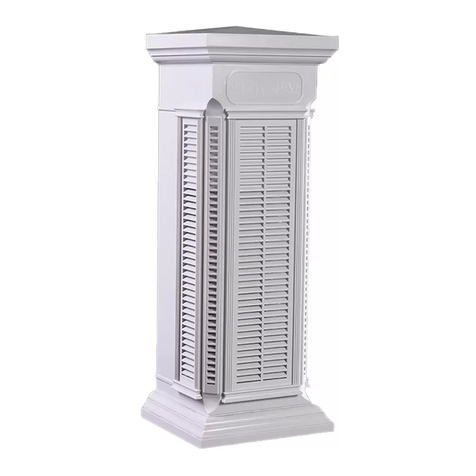
Paraclipse
Paraclipse Mosquito Eliminator Maintenance instructions
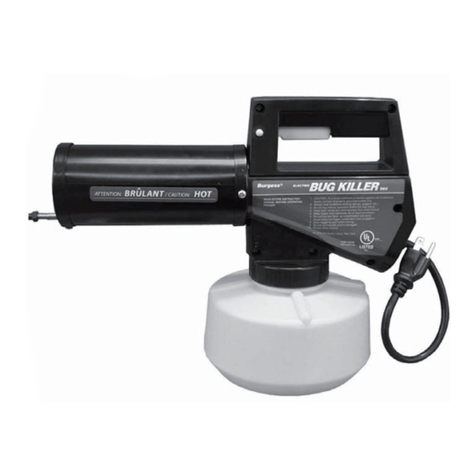
Fountainhead
Fountainhead Black Flag user manual
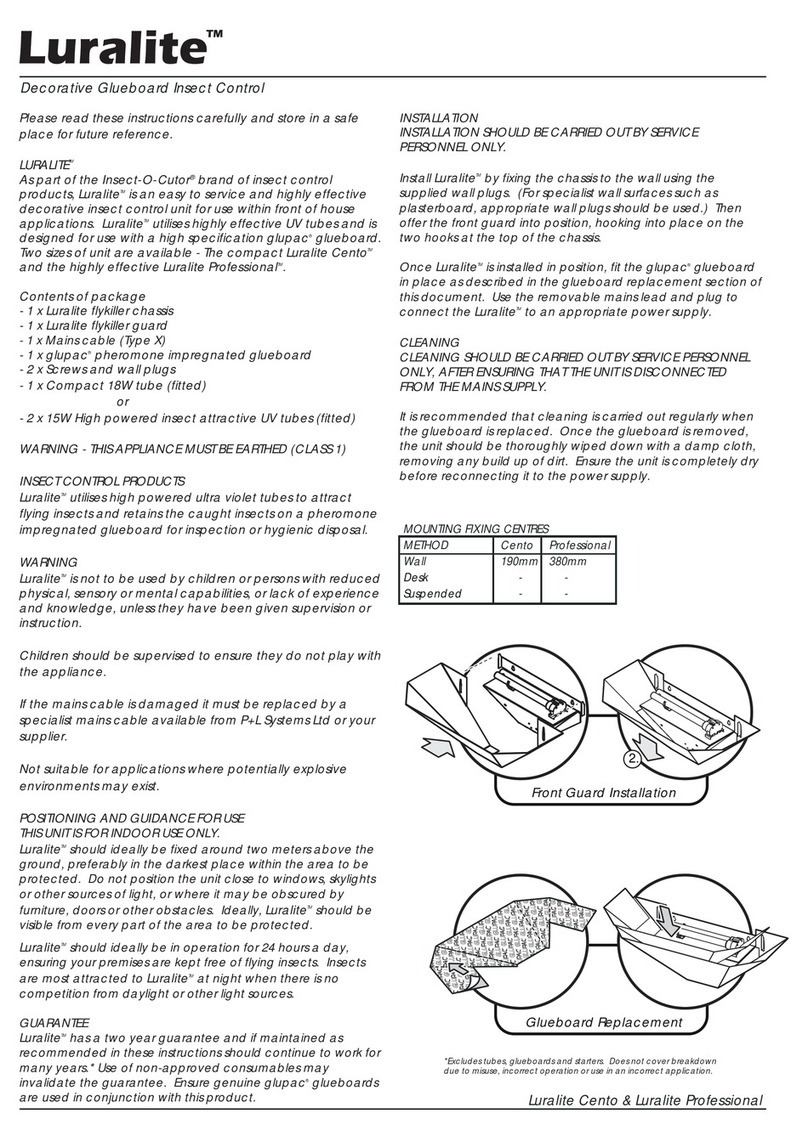
INSECT-O-CUTOR
INSECT-O-CUTOR Luralite Cento user manual

BioMetrixx
BioMetrixx S1 quick start guide

Green Strike
Green Strike Outdoor Flying Insect Trap owner's manual
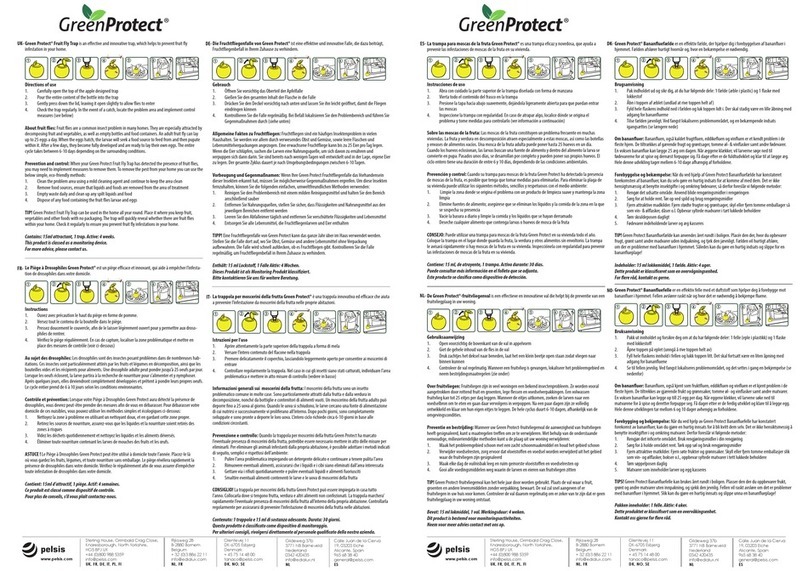
Pelsis
Pelsis Green Protect Fruit Fly Trap Instructions for use

Streamline
Streamline Vivid PRO SF-FG03-220 instruction manual
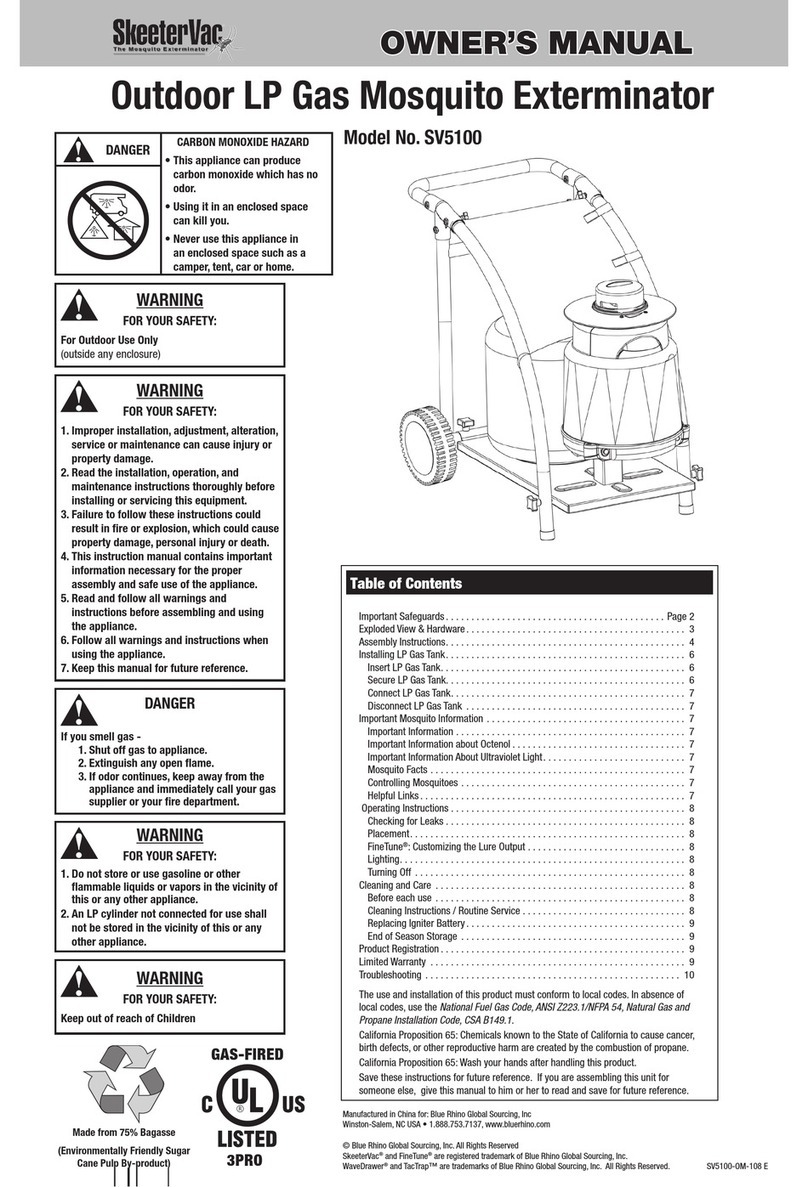
SkeeterVac
SkeeterVac SV5100 owner's manual
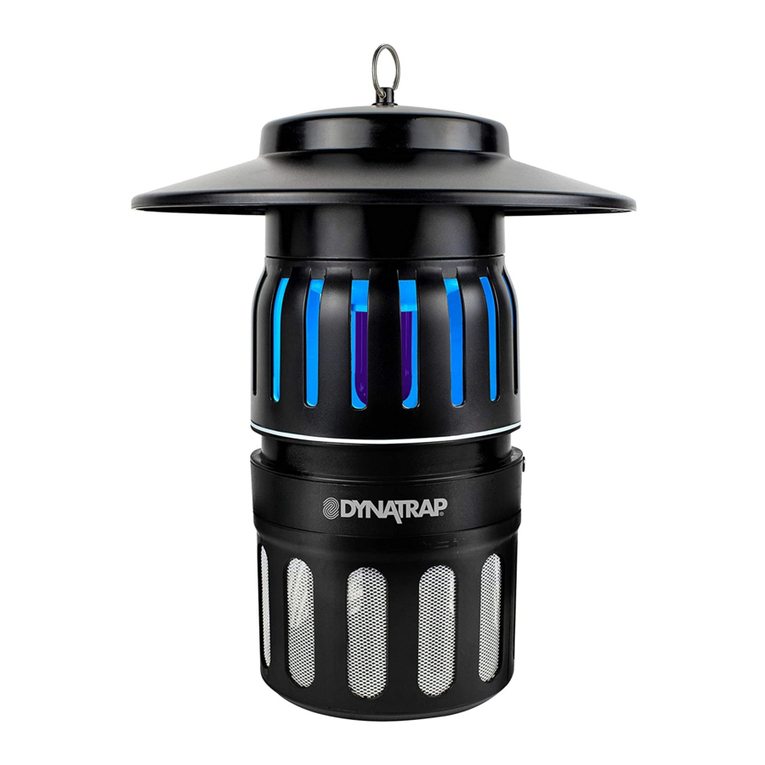
DynaTrap
DynaTrap DT1050-CSTCA owner's manual
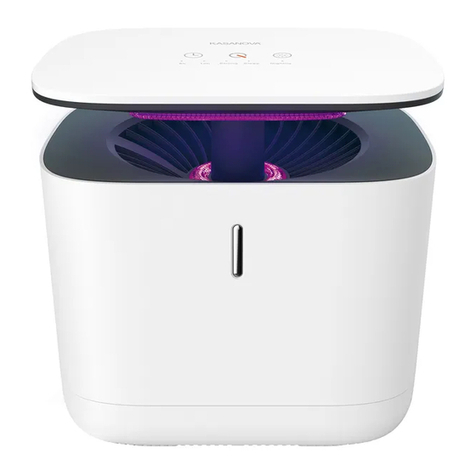
Kasanova
Kasanova TNJ000003NOC instruction manual

INSECT-O-CUTOR
INSECT-O-CUTOR EX55 instruction manual
